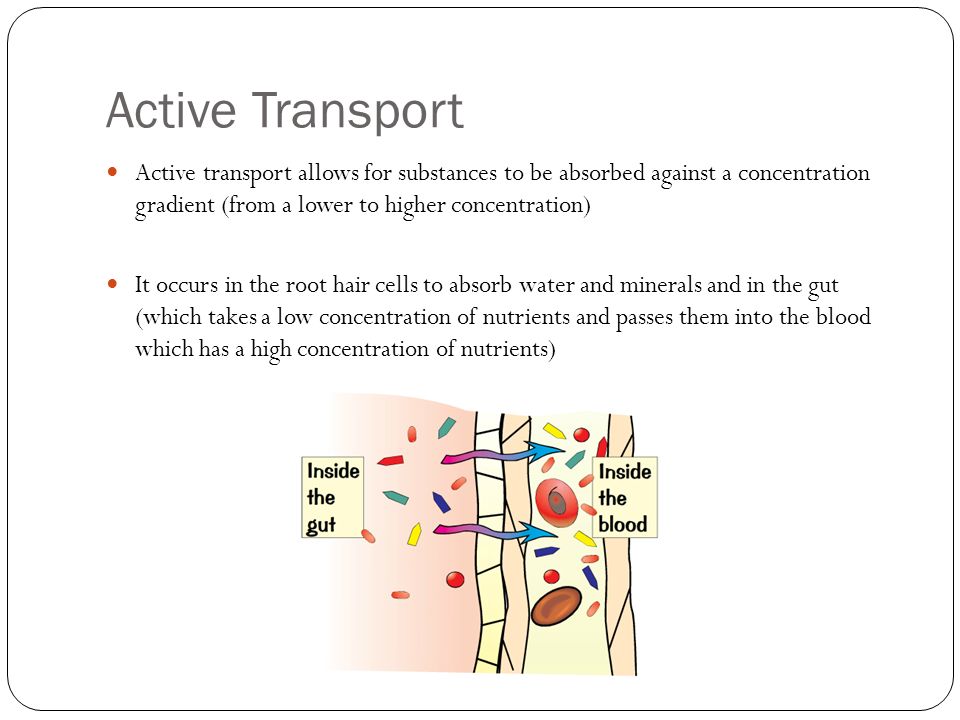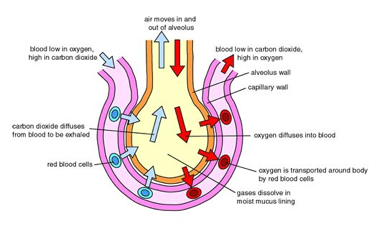Transport In Cells
- Created by: Maria is the best
- Created on: 18-11-18 13:44
Diffusion
Diffusion=spreading out of particles from an area of high concentration to low concentration. Diffusion only happens in solutions and gases because the particles in these substances free to move about randomly. Diffusion across cell membranes - cell membranes hold cell together but also let stuff in and out. Dissolved substances can move in&out of cells=diffusion. Only very small molecules can diffuse through membrane=oxygen, glucose...but not big molecules (starch,proteins).
Rate of Diffusion - affected by:
- conc. gradient=bigger conc. gradient=faster rate of diffusion
- temp=higher temp=faster rate of diffusion because particles=more energy=move faster
- surface area=larger surface area=faster rate of diffusion=more particles can pass through at once
Diffusion Diagram
Osmosis
Osmosis=movement of water across partially permeable membrane from region of high to low water conc. Osmosis=type of diffusion=passive=requires no energy
Hypertonic - high solute concentration (hypertonic to hypotonic). Red blood cells and root hairs are hypertonic.
Isotonic - means equal concentration.
Hypotonic - lower solute concentration. pure water is hypotonic. soil is hypotonic so goes to root hair of plant.
Osmosis Diagram
Active Transport
Active Transport=movement of particles against a concentration gradient (from an area of low to high concentration) using energy transferred during respiration (not passive).
Active Transport in plant roots - cells on on surface of plants grow into long 'hairs' which stick out into soil. Each branch of root=covered in millions of microscopic hairs=gives plant big surface area for absorbing water&mineral ions from soil. Plants need these mineral ions for healthy growth. However concentration of minerals usually higher in root cell than soil=Active Transport.
Active Transport in plant roots Diagram

Active Transport in the gut
Active Transport used in digestive system when is lower concentration of nutrients in gut but higher concentration of nutrients in blood.
When there's higher concentration of glucose+amino acids in gut=diffuse naturally into blood. BUT sometimes=lower conc. of nutrients in gut than is in blood=means conc. gradient=worng way=active transport.
Active transport allows nutrient to be taken in blood=essential to stop us starving=means glucose can be taken into bloodstream when its conc. in blood=already higher than in gut. Glucose can then be transported to cell=where it's used for respiration.
Active Transport in the gut Diagram

Exchanging Substances
Gas Exchange in humans - job of lungs to transfer oxygen to blood & remove carbon dioxide. To do this=lungs contain millions of little air sacs=alveoli where gas exchange takes place.
Alveoli surrounded by network of tiny blood vessels=capillaries=high conc. of oxygen in air than blood=oxygen diffuses out of air in alveoli&into blood in capillaries. CO2 diffuses in opposite direction. Air enters + leaves alveoli via small tubes=bronchioles.
Adaptations of alveoli:
- enormous surface area
- moist lining for dissolving gases
- very thin walls
- good blood supply
Gas Exchange Diagram

Absorbing products of digestion
Nutrients (glucose,amino scids..) absorbed into bloodstream from small intestine (by diffusion or active transport). To aid this absorption inside of small intestine covered in millions&millions of tiny little projections=villi.
Villi increase surface area in big way so that digested food absorbed much more quickly into blood. They also have:
- single layer surface cells
- very good blood supply to assist quick absorption
Absorbing products of digestion Diagram

Gas Exchange in Leaves
Plants need CO2 for photosynthesis. CO2 diffuses into air spaces within leaf then diffuses into cells where photosynthesis happens. Leaf's structure adapted so that this can happen easily.
Underneath of leaf=exchange surface=covered in little holes=stomata which CO2 diffuses in through. Oxygen and water vapour also diffuse out through stomata.
Flattened shape of leaf increases area of this exchange surface=more effective. Walls of cells inside leaf form another exchange surface. The spaces inside leaf increase surface area=more chance for CO2 to get into cells.
Water loss in plants - Water vapour lost from all over leaf surface but most lost through stomata. If plant=losing water faster through leaves then can be replaced by roots & stomata can be closed by guard cells. Without guard cells=plant would lose so much water that it would wilt.
Gas Exchange in Leaves Diagram
Gas Exchange in Fish
is lower conc. of oxygen in water than air=fish have special adaptations to get enough of it. In fish=gas exchange surface in gills.
Structure of gills - water (containing oxygen) enters fish through its mouth & passes out through gills. As this happens=oxygen diffuses from water into blood in gills & carbon dioxide diffuses from blood into water. Each gill made of lots of thin plates=gill filaments=large surface area for gas exchange=rate of diffusion increased. Gill filaments covered in lots of tiny structures=lamellae=increase surface area even more. The lamellae have lots of blood capillaries to speed up diffusion between the water&blood=also have thin surface layer of cells to minimise distance the gases have to diffuse. Blood flows through lamellae in one direction + water flows over in opposite direction=maintains large conc. gradient between water&blood. The conc. of oxygen in water=always higher than that in blood=as much oxygen as possible diffuses from water into blood.
Gas Exchange in Fish Diagram
Gas Exchange in Fish Diagram 2
Related discussions on The Student Room
- Alevel bio synoptic essay »
- AQA A-level biology essay topics »
- a level biology help »
- AQA Biology essay »
- best field to specialise in materials science and engineering? »
- Access to Science course »
- Chromosomes a level biology »
- AQA A Level Biology Paper 1 7402/1 - 9 Jun 2022 [Exam Chat] »
- AQA A-Level Biology Paper 3 [21st June 2023] Exam Chat »
- AQA AS Biology 2022 »
Comments
No comments have yet been made